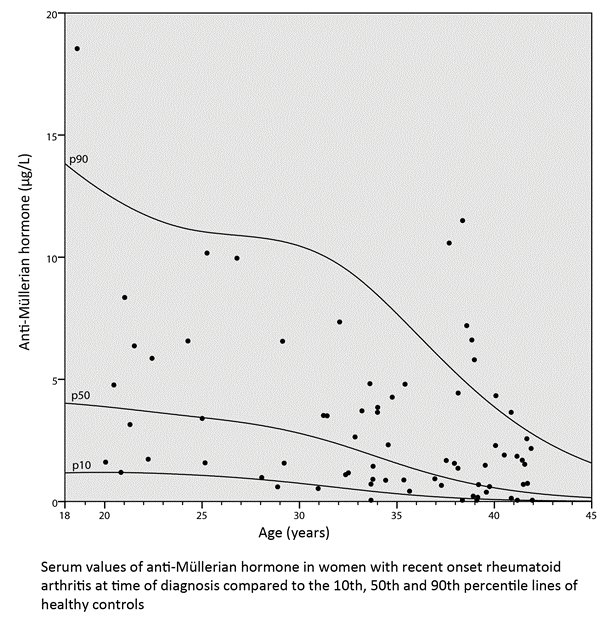Session Information
Title: Rheumatoid Arthritis - Clinical Aspects II: Clinical Features & Comorbidity/Cardiovascular Disease
Session Type: Abstract Submissions (ACR)
Background/Purpose: Planning of pregnancy is important in women with rheumatoid arthritis (RA). It is preferred to start a pregnancy after adjustment of medication and when disease activity is low. Therefore, it is important to know the ovarian reserve in these women, since a reduced ovarian reserve is associated with subfertility and early menopause. It has been shown in healthy women, that anti-Müllerian hormone (AMH) is a good biomarker for ovarian reserve. Prior to using AMH for this purpose in women with RA, the influence of disease activity and medication use, in particular methotrexate, should be assessed.
Methods: Serum levels of anti-Müllerian hormone were measured in women aged 18 to 42 years with recent onset RA (according to the 2010 ACR/EULAR rheumatoid arthritis classification criteria) at time of diagnosis (before treatment was started) and six months later. The control group existed of 509 healthy women aged 18 to 42 years. The relationships between AMH and presence of rheumatoid factor (RF), anti-cyclic citrullinated peptide (anti-CCP), erosions, values of C-reactive protein (CRP), disease activity (measured by DAS28) and use of methotrexate (MTX) were assessed.
Results: Serum samples were available for 72 patients at time of diagnosis. Patients were older (median age 35,1 years (IQR 30,1–39,2)) than controls (29,4 years (IQR 23,8–34,4)) (p<0,001). Serum values of AMH, adjusted for age, did not differ significantly between patients (1,71 μg/L (IQR 0,81–4,39 μg/L)) and controls (2,82 μg/L (IQR 1,64–4,38 μg/L)) (p=0,254). AMH levels were not related to the presence of RF (p=0,487), anti-CCP (p=0,686) or erosions (p=0,350) and did not show a significant correlation with serum CRP levels (r = -0,207, p=0,083) or disease activity scores (DAS28, r = 0,007, p=0,955).
After six months of treatment, serum was available for 53 patients, of whom 31 patients (58%) were prescribed MTX. AMH levels after six months were significantly lower in these patients (1,92 μg/L (IQR 0,84–3,75)) than at time of diagnosis (2,57 μg/L (IQR 0,90 – 5,30)) (p<0,001), but did not differ from the controls after adjustment for age (p=0,741). There was no significant difference in AMH values after six months of treatment between patients who did or did not receive MTX (p=0,287).
Conclusion: In women with recent onset RA, serum AMH levels are not affected by disease activity or short term use of methotrexate. Therefore, serum AMH levels can be used as a marker for ovarian reserve in women with RA. AMH levels are not reduced in women with recent onset RA compared to controls. Further research is needed to study the long term effects of rheumatologic disease and medication use on ovarian reserve in women with RA.
Disclosure:
J. Brouwer,
None;
J. M. W. Hazes,
None;
J. S. E. Laven,
None;
I. Schipper,
None;
R. J. E. M. Dolhain,
None.
« Back to 2012 ACR/ARHP Annual Meeting
ACR Meeting Abstracts - https://acrabstracts.org/abstract/serum-anti-mullerian-hormone-can-be-used-to-determine-ovarian-reserve-in-women-with-rheumatoid-arthritis/

